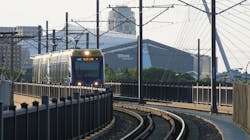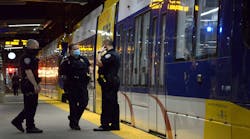Will fewer light-rail vehicles improve customer experience? Metro Transit is testing it out.
Metro Transit in Minneapolis, Minn., is reducing the number of light-rail vehicles in a train from three to two. The move will test if a reduced number of cars in a train improves the customer experience; more specifically, will the reduced number of cars help customers feel safer.
Both the METRO Blue and Green Lines will see reduced rail cars as part of the program, which will take place July 9 through Aug. 19. The test program is part of the agency’s Safety & Security Action Plan. The plan identifies 40 actions based around three areas of work – improving conditions of the system, training and supporting employees and engaging customers and partners – as a way to improve public safety on the transit network.
“Three-car vehicle sets have been our standard since the Green Line opened, but times have changed and we need to be open to all new ideas,” said Metro Transit Chief Operating Officer Brian Funk.
Each light-rail vehicle can hold up to 132 passengers. Crowding on light-rail trains shouldn’t be a concern with Metro Transit explaining light-rail ridership is at about half of pre-pandemic levels.
Customer feedback will determine if adjustments are required and Metro Transit may also make special consideration for those times when ridership is expected to be higher.
At the program’s conclusion, next steps will be determined by customer and train operator feedback and other evaluation measures, like on-time performance.

Mischa Wanek-Libman | Group Editorial Director
Mischa Wanek-Libman is director of communications with Transdev North America. She has more than 20 years of experience working in the transportation industry covering construction projects, engineering challenges, transit and rail operations and best practices.
Wanek-Libman has held top editorial positions at freight rail and public transportation business-to-business publications including as editor-in-chief and editorial director of Mass Transit from 2018-2024. She has been recognized for editorial excellence through her individual work, as well as for collaborative content.
She is an active member of the American Public Transportation Association's Marketing and Communications Committee and served 14 years as a Board Observer on the National Railroad Construction and Maintenance Association (NRC) Board of Directors.
She is a graduate of Drake University in Des Moines, Iowa, where she earned a Bachelor of Arts degree in Journalism and Mass Communication.


